TOYOTA PROACE 2019 Owners Manual (in English)
Manufacturer: TOYOTA, Model Year: 2019, Model line: PROACE, Model: TOYOTA PROACE 2019Pages: 516, PDF Size: 90.91 MB
Page 121 of 516
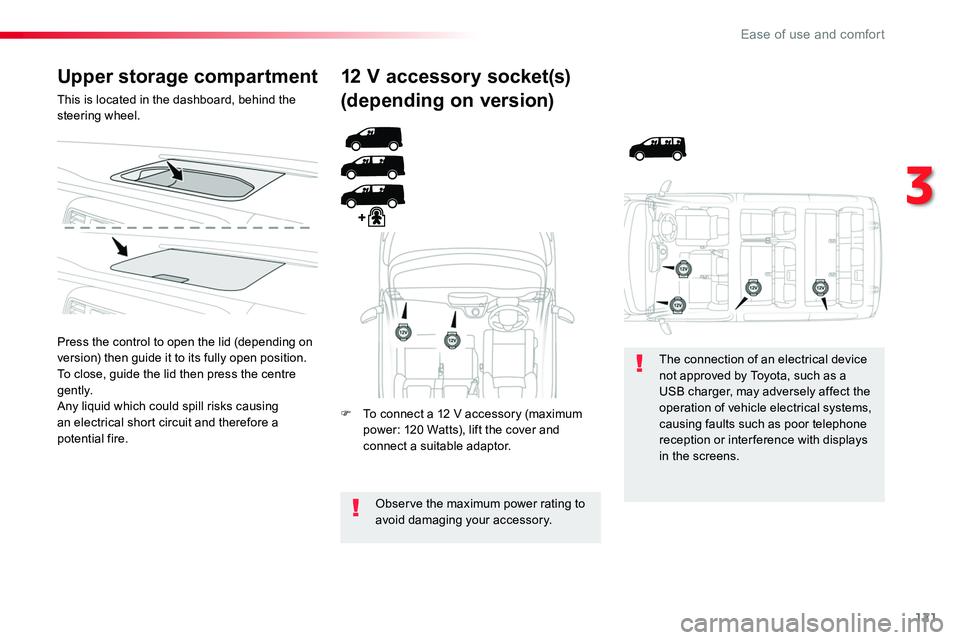
121
Upper storage compartment
This is located in the dashboard, behind the steering wheel.
Press the control to open the lid (depending on version) then guide it to its fully open position.To close, guide the lid then press the centre g e nt l y.Any liquid which could spill risks causing an electrical short circuit and therefore a potential fire.
12 V accessory socket(s)
(depending on version)
F To connect a 12 V accessory (maximum power: 120 Watts), lift the cover and connect a suitable adaptor.
Observe the maximum power rating to avoid damaging your accessory.
The connection of an electrical device not approved by Toyota, such as a USB charger, may adversely affect the operation of vehicle electrical systems, causing faults such as poor telephone reception or inter ference with displays in the screens.
3
Ease of use and comfort
Page 122 of 516
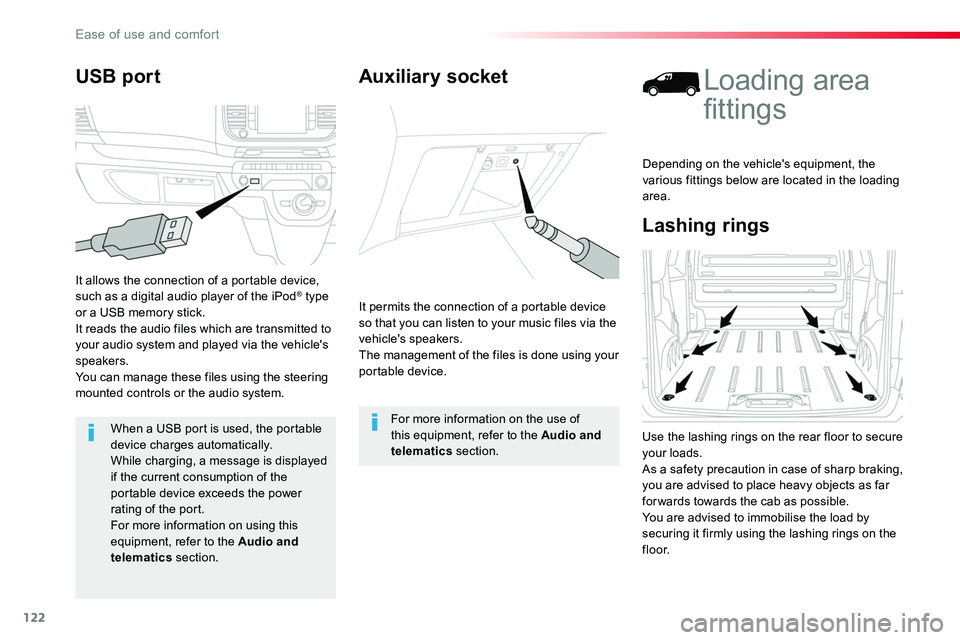
122
Auxiliary socket
It permits the connection of a portable device so that you can listen to your music files via the vehicle's speakers.The management of the files is done using your portable device.
For more information on the use of this equipment, refer to the Audio and telematics section.
Lashing rings
Loading area
fittings
Use the lashing rings on the rear floor to secure your loads.As a safety precaution in case of sharp braking, you are advised to place heavy objects as far for wards towards the cab as possible.You are advised to immobilise the load by
securing it firmly using the lashing rings on the f l o o r.
Depending on the vehicle's equipment, the various fittings below are located in the loading area.
USB port
It allows the connection of a portable device, such as a digital audio player of the iPod® type or a USB memory stick.It reads the audio files which are transmitted to your audio system and played via the vehicle's speakers.You can manage these files using the steering mounted controls or the audio system.
When a USB port is used, the portable
device charges automatically.While charging, a message is displayed if the current consumption of the portable device exceeds the power rating of the port.For more information on using this equipment, refer to the Audio and telematics section.
Ease of use and comfort
Page 123 of 516
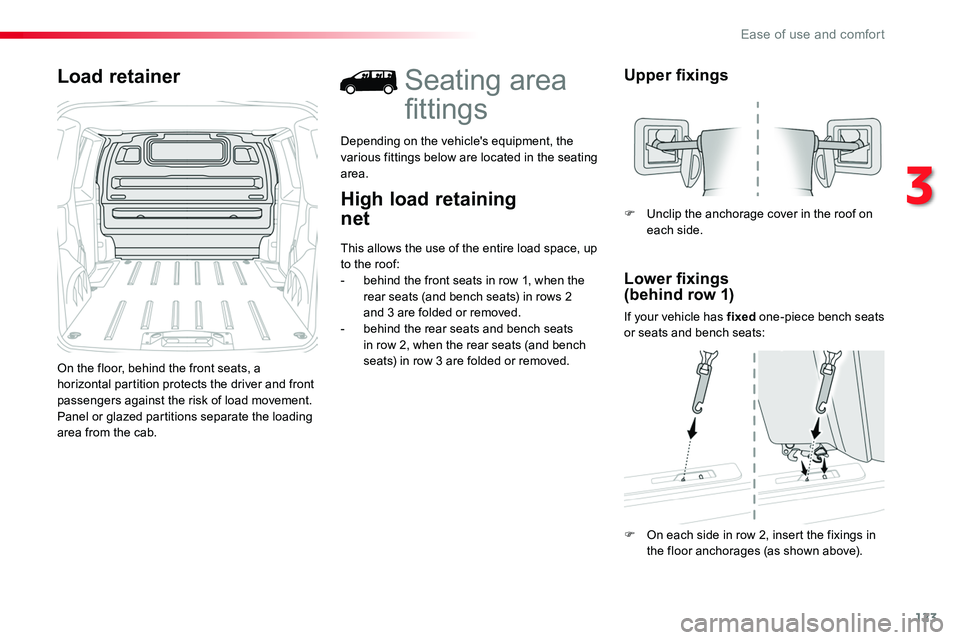
123
Load retainer
On the floor, behind the front seats, a horizontal partition protects the driver and front passengers against the risk of load movement.Panel or glazed partitions separate the loading area from the cab.
High load retaining
net
Seating area
fittings
Depending on the vehicle's equipment, the various fittings below are located in the seating area.
This allows the use of the entire load space, up to the roof:- behind the front seats in row 1, when the rear seats (and bench seats) in rows 2 and 3 are folded or removed.- behind the rear seats and bench seats in row 2, when the rear seats (and bench seats) in row 3 are folded or removed.
Upper fixings
Lower fixings (behind row 1)
If your vehicle has fixed one-piece bench seats or seats and bench seats:
F Unclip the anchorage cover in the roof on
each side.
F On each side in row 2, insert the fixings in the floor anchorages (as shown above).
3
Ease of use and comfort
Page 124 of 516
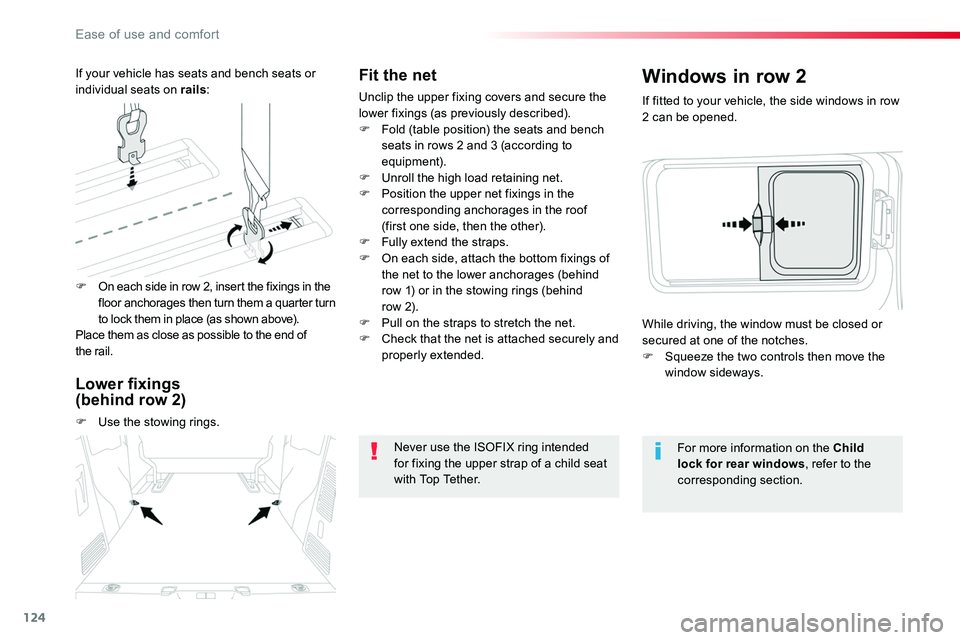
124
Fit the net
Unclip the upper fixing covers and secure the lower fixings (as previously described).F Fold (table position) the seats and bench seats in rows 2 and 3 (according to equipment).F Unroll the high load retaining net.F Position the upper net fixings in the corresponding anchorages in the roof (first one side, then the other).F Fully extend the straps.F On each side, attach the bottom fixings of the net to the lower anchorages (behind row 1) or in the stowing rings (behind row 2).F Pull on the straps to stretch the net.F Check that the net is attached securely and properly extended.
Never use the ISOFIX ring intended for fixing the upper strap of a child seat with Top Tether.
If fitted to your vehicle, the side windows in row 2 can be opened.
Windows in row 2
For more information on the Child lock for rear windows, refer to the corresponding section.
While driving, the window must be closed or secured at one of the notches.F Squeeze the two controls then move the window sideways.
F On each side in row 2, insert the fixings in the floor anchorages then turn them a quarter turn to lock them in place (as shown above).Place them as close as possible to the end of the rail.
If your vehicle has seats and bench seats or individual seats on rails:
Lower fixings (behind row 2)
F Use the stowing rings.
Ease of use and comfort
Page 125 of 516
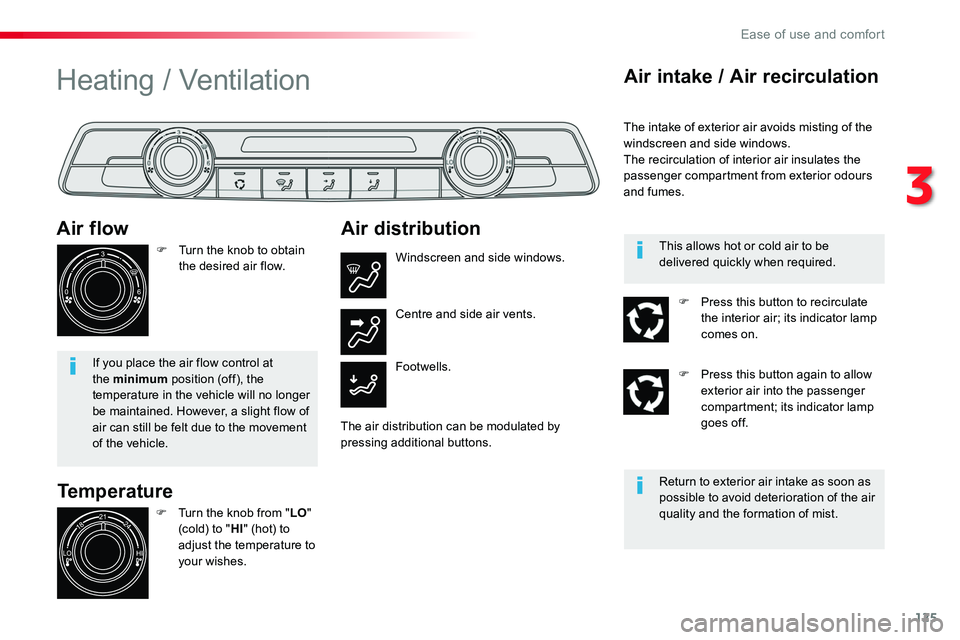
125
Temperature
Air flow
F Turn the knob to obtain the desired air flow.
If you place the air flow control at the minimum position (off), the temperature in the vehicle will no longer be maintained. However, a slight flow of air can still be felt due to the movement of the vehicle.
Heating / Ventilation
F Turn the knob from "LO" (cold) to "HI" (hot) to
adjust the temperature to your wishes.
Air distribution
Windscreen and side windows.
Footwells.
Centre and side air vents.
The air distribution can be modulated by pressing additional buttons.
Air intake / Air recirculation
The intake of exterior air avoids misting of the windscreen and side windows.The recirculation of interior air insulates the passenger compartment from exterior odours and fumes.
Return to exterior air intake as soon as possible to avoid deterioration of the air quality and the formation of mist.
This allows hot or cold air to be delivered quickly when required.
F Press this button to recirculate the interior air; its indicator lamp comes on.
F Press this button again to allow exterior air into the passenger compartment; its indicator lamp goes off.
3
Ease of use and comfort
Page 126 of 516
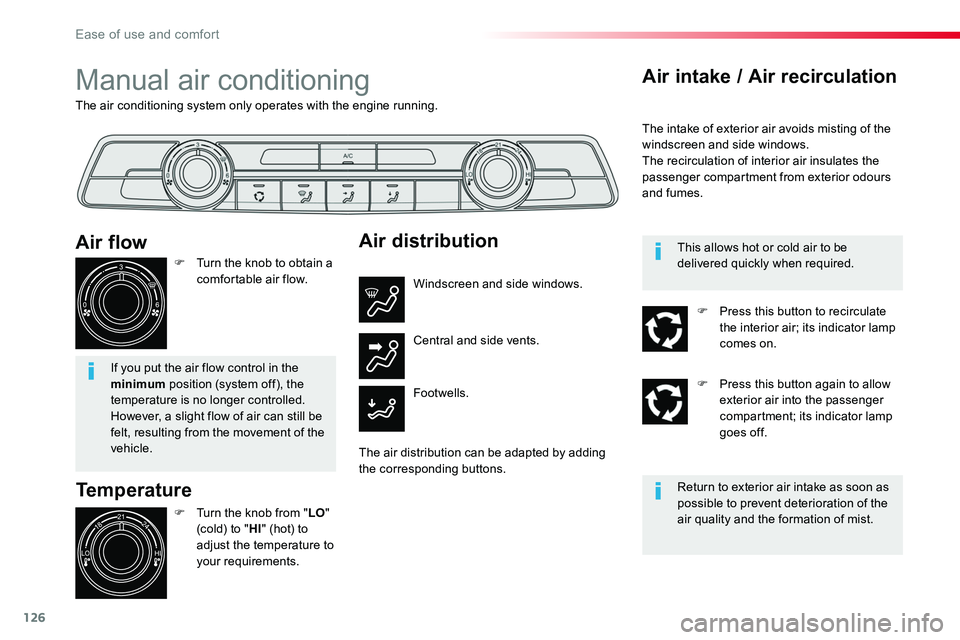
126
The air conditioning system only operates with the engine running.
Manual air conditioning
Temperature
F Turn the knob from "LO" (cold) to "HI" (hot) to
adjust the temperature to your requirements.
Air flow
F Turn the knob to obtain a comfortable air flow.
If you put the air flow control in the minimum position (system off), the temperature is no longer controlled. However, a slight flow of air can still be
felt, resulting from the movement of the vehicle.
Air distribution
Windscreen and side windows.
Footwells.
Central and side vents.
The air distribution can be adapted by adding the corresponding buttons.
Air intake / Air recirculation
The intake of exterior air avoids misting of the windscreen and side windows.The recirculation of interior air insulates the passenger compartment from exterior odours and fumes.
Return to exterior air intake as soon as possible to prevent deterioration of the air quality and the formation of mist.
This allows hot or cold air to be delivered quickly when required.
F Press this button to recirculate the interior air; its indicator lamp comes on.
F Press this button again to allow exterior air into the passenger compartment; its indicator lamp goes off.
Ease of use and comfort
Page 127 of 516
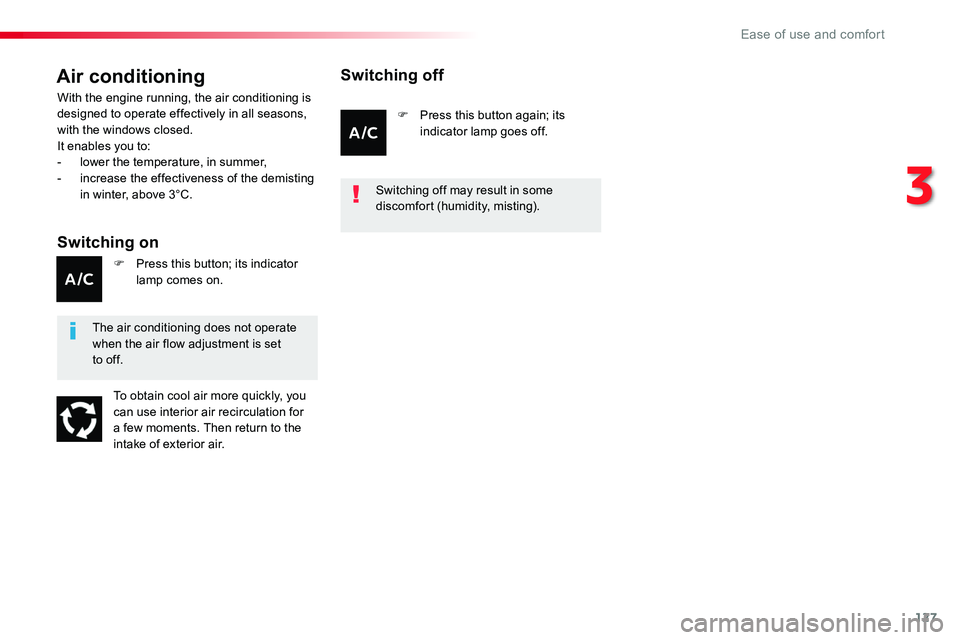
127
Air conditioning
Switching on
With the engine running, the air conditioning is designed to operate effectively in all seasons, with the windows closed.It enables you to:- lower the temperature, in summer,- increase the effectiveness of the demisting in winter, above 3°C.
To obtain cool air more quickly, you can use interior air recirculation for a few moments. Then return to the intake of exterior air.
F Press this button; its indicator lamp comes on.
F Press this button again; its indicator lamp goes off.
Switching off
The air conditioning does not operate when the air flow adjustment is set to off.
Switching off may result in some discomfort (humidity, misting).
3
Ease of use and comfort
Page 128 of 516

128
A setting around 21 enables you to obtain an optimum level of comfort. Depending on your requirements, a setting between 18 and 24 is usual.In addition, it is recommended that you avoid a left /right setting difference of more than 3.
Dual-zone automatic air conditioning
Offers the best compromise between a comfortable temperature and quiet operation.
Provides soft and quiet operation by limiting air flow.
Provides strong and effective air flow.
F Press the "AUTO" button repeatedly.
Automatic comfort mode
Temperature
F Push the button down to reduce the value or up to increase it.When the engine is cold, the air flow will only reach its optimum level gradually to prevent too great a distribution of c o l d a i r.In cold weather, it favours the distribution of warm air to the windscreen, the side windows and the footwells only.
The active mode appears in the display screen, as described below:
If desired, you can choose settings different to those offered by the system, by adjusting a setting manually. The other functions are still managed automatically.The "AUTO" symbol disappears if you modify a setting.
Manual mode
The driver and front passenger can each set the temperature to suit their requirements.The value indicated in the screen corresponds to a level of comfort and not to a temperature in degrees Celsius or Fahrenheit.
Ease of use and comfort
Page 129 of 516
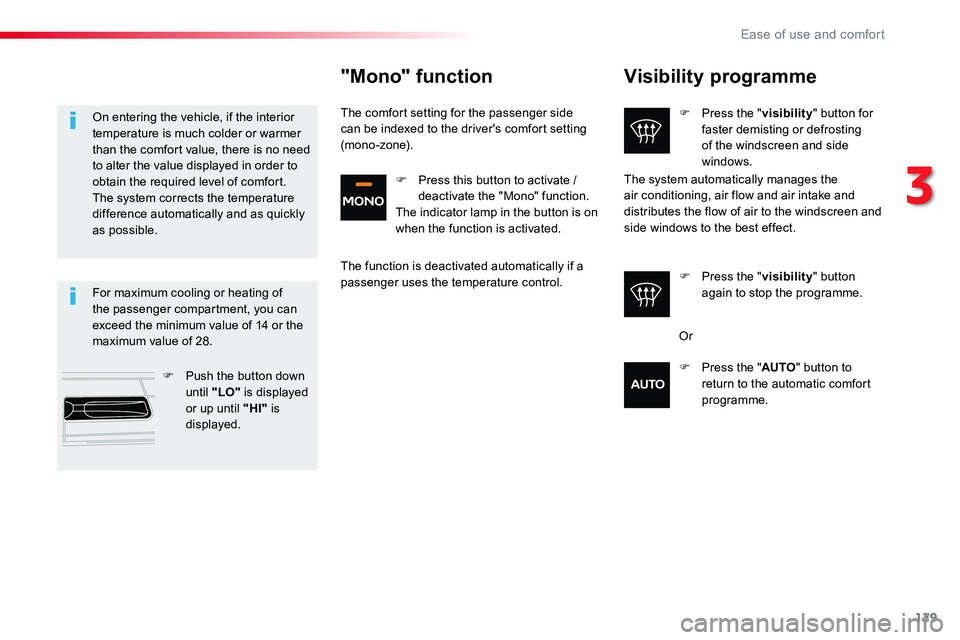
129
Visibility programme
F Press the "visibility" button for faster demisting or defrosting of the windscreen and side windows.
F Press the "visibility" button again to stop the programme.
The system automatically manages the air conditioning, air flow and air intake and distributes the flow of air to the windscreen and
side windows to the best effect.
For maximum cooling or heating of the passenger compartment, you can exceed the minimum value of 14 or the maximum value of 28.
F Push the button down until "LO" is displayed or up until "HI" is displayed.
On entering the vehicle, if the interior temperature is much colder or warmer than the comfort value, there is no need to alter the value displayed in order to obtain the required level of comfort. The system corrects the temperature difference automatically and as quickly as possible.
"Mono" function
The comfort setting for the passenger side can be indexed to the driver's comfort setting (mono-zone).
The function is deactivated automatically if a passenger uses the temperature control.
Or
F Press the "AUTO" button to return to the automatic comfort programme.
F Press this button to activate / deactivate the "Mono" function.The indicator lamp in the button is on when the function is activated.
3
Ease of use and comfort
Page 130 of 516
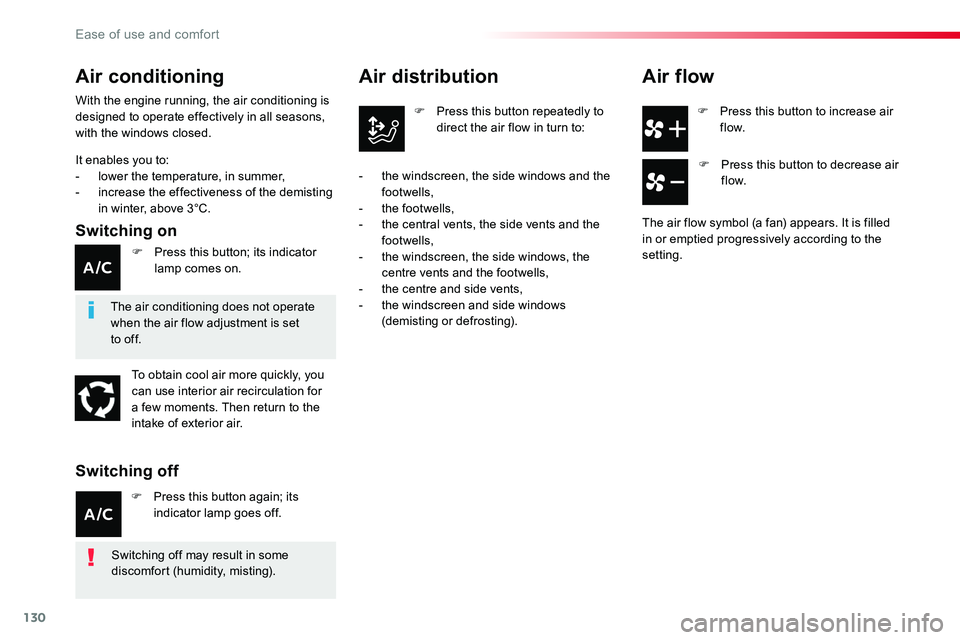
130
F Press this button to increase air f low.
Air distribution
F Press this button repeatedly to direct the air flow in turn to:
- the windscreen, the side windows and the footwells,- the footwells,
- the central vents, the side vents and the footwells,- the windscreen, the side windows, the centre vents and the footwells,- the centre and side vents,- the windscreen and side windows (demisting or defrosting).
Air flow
F Press this button to decrease air f low.
The air flow symbol (a fan) appears. It is filled in or emptied progressively according to the setting.
Air conditioning
It enables you to:- lower the temperature, in summer,- increase the effectiveness of the demisting in winter, above 3°C.
Switching on
With the engine running, the air conditioning is designed to operate effectively in all seasons, with the windows closed.
The air conditioning does not operate when the air flow adjustment is set to off.
To obtain cool air more quickly, you can use interior air recirculation for a few moments. Then return to the intake of exterior air.
F Press this button; its indicator lamp comes on.
F Press this button again; its indicator lamp goes off.
Switching off
Switching off may result in some discomfort (humidity, misting).
Ease of use and comfort